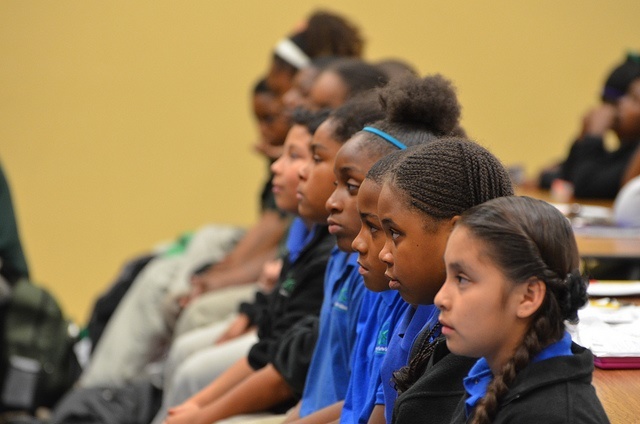Access to charter schools is driving increases in student achievement in some of the nation’s toughest locales for education.
Schools in the nation’s capital, for example, achieved minimal gains in 2014, but they did incrementally increase across the board
The city’s charter schools face tough authorizing requirements and expectations while functioning at a lower per pupil cost than traditional city schools. They outperformed traditional public schools again this year: 2014 is the ninth year public charter schools in the city averaged scores above DC Public Schools in math and reading on the DC Comprehensive Assessment System tests. Public charter school students in the city averaged 59.6 in math and 53.4 percent in reading compared to DCPS scores of 53 and 49.5.
Serving high levels of underprivileged and ethnically diverse students, the District exhibits the common result of a healthy charter school environment; public charters in the city outperform their traditional counterparts while increasing achievement of low-income, minority, and ESL-students.
Other Urban Locales
A year after implementation of Common Core standards in New York, both traditional and charter public schools experienced a drop in scores, but charter schools still came out on top with higher average scores in 2014.
Among high-poverty schools with naturally occurring socioeconomic and ethnic diversity, half of the top ten performers in both math and reading were charters.
Chicago has yet to produce a proven track record of charter performance, but although selective-enrollment, admissions-based public schools outperformed charter and traditional public schools in the state, charter schools edged out students in traditional public schools in ACT scores, graduation rates, and attendance, according to a Chicago Public Schools spokesperson.
The Center for Research on Education Outcomes at Stanford University found in 23 states, plus New York City and Washington, DC, students at public charters outperform their traditional public school peers in reading while making significant strides in math.
Flying and Failing
Not all charters are succeeding, but whereas failing traditional public schools continue to receive ample and even increased funding, failing charters are quickly and effectively shut down.
Charters are built to meet high academic standards, with financial and organizationally demanding structures that function as parts of proven networks or are independently authorized. Their autonomy and adaptability allow for personalized, student-based education, usually based on proven successes but often implementing experimental designs by scholars and community leaders. The experiment phase comes quickly to an end if performance doesn’t measure up.
What critics fail to recognize is outcome disparity in charter environments indicates a healthy system. Some schools fly, while others fail. Accountability is monitored, measured, and marked; charters that fail to thrive after a typical trial period of three years are shut down and the system moves on.
Some Are Top-Ranked
Public charters in some cities outperformed top-ranked national and international schools.
Juniors at Liberty Common High School in Fort Collins, Colorado posted a 2014 average score of 28.63 out of 36 on the ACT, breaking the state record high in 2014. That record accounted for new high scores in each area of testing. The school was founded in 2010 and has been on the fast track to success by “accentuating math, science and engineering” in a classical liberal-arts curriculum. The state’s previous record holder is another charter, the Vanguard School, in Colorado Springs.
BASIS Tucson North, a PCS in Tucson, Arizona, outperformed 40 countries on the Programme for International Student Assessments when last administered in 2012, averaging a math score of 618, 131 points above the average for all U.S. schools. The school is one of the top five in the nation, according to the Washington Post and U.S. News & World Report.
BASIS’s DC school boasted an overall increase of 3.8 percentage points in this year’s DC CAS standardized test, with students scoring 82.9 percent overall.
KIPP DC’s PCS had proficiency scores of 94.5 and 71 in math and reading.
Double-digit score gains at Imagine Hope PCS–Lamond and Friendship PCS–Collegiate Academy showed improvement, and several other charters increased their scores by double-digit percentage points.
In addition, the Center for Reinventing Public Education and Mathematics Policy Research found charter students enjoyed higher graduation rates and college matriculation, plus higher-paying careers.
Current Policy Climate
Updating and recognizing charter policy is necessary to adequately serve a growing demand; more than 6,000 public charters schools serve 2.3 million students nationwide.
Current priority states for charter reform, according to the National Alliance for Public Charter Schools, are Kentucky and Oklahoma. Kentucky is one of eight states in the country with no law supporting charter schools, and Oklahoma’s law is judged as weak; only a small fraction of districts allow charters, funding is largely inequitable compared with traditional public schools, and there is no statewide authorizing board.
A federal bill sponsored by U.S. Rep. George Miller and U.S. Rep. John Kline, chairman of the House Education and Workforce Committee, would allow new charters to receive funding without a proven track record of success. The Success and Opportunity through Quality Charter Schools Act, H.R. 10 will streamline charter success by replicating proven quality and innovative practices from public charter schools.
Charter Expansion
Washington, DC’s first Rocketship charter school will break ground this year, set to open its doors in 2015.
The DC Public Charter School Board unanimously approved applications for two schools serving 650 students each. Rocketship is currently refocusing expansion into four regions of the country, including the nation’s capital.
Ashley Bateman ([email protected]) writes from Alexandria, Virginia.
Image by Ms. SmittyB.




